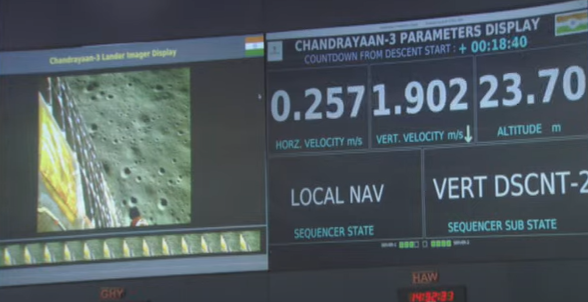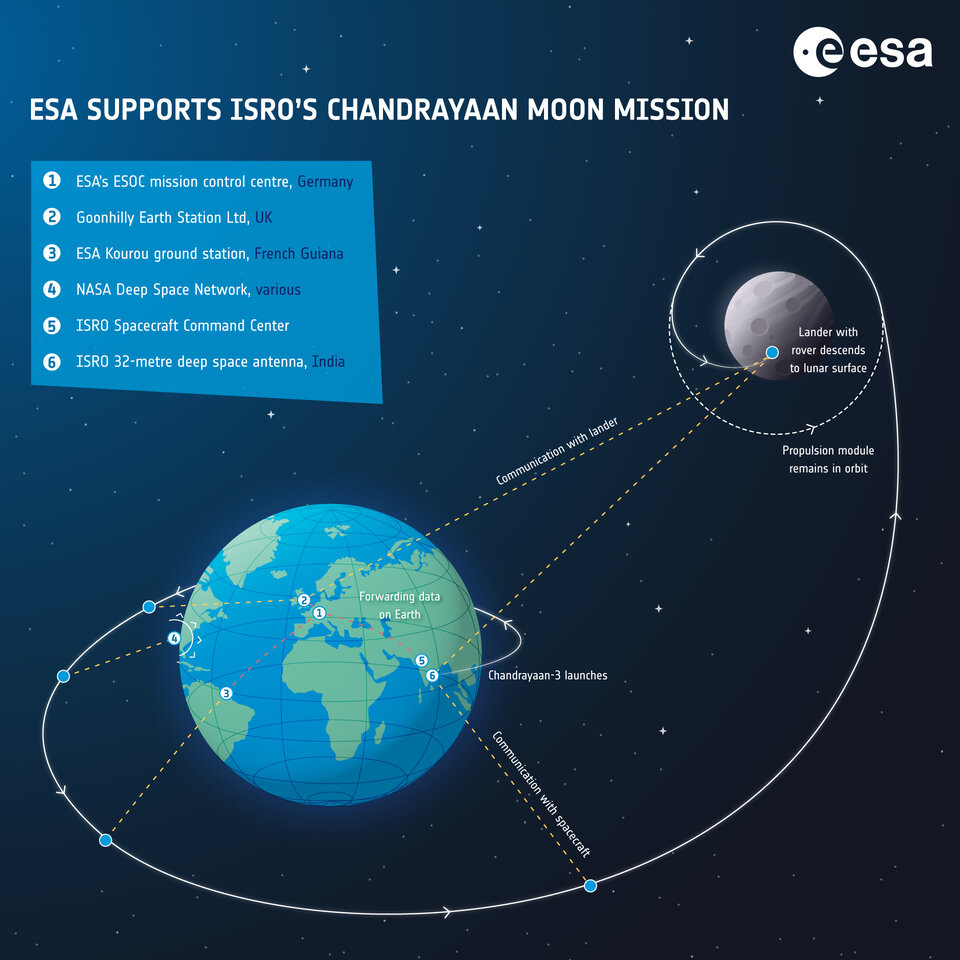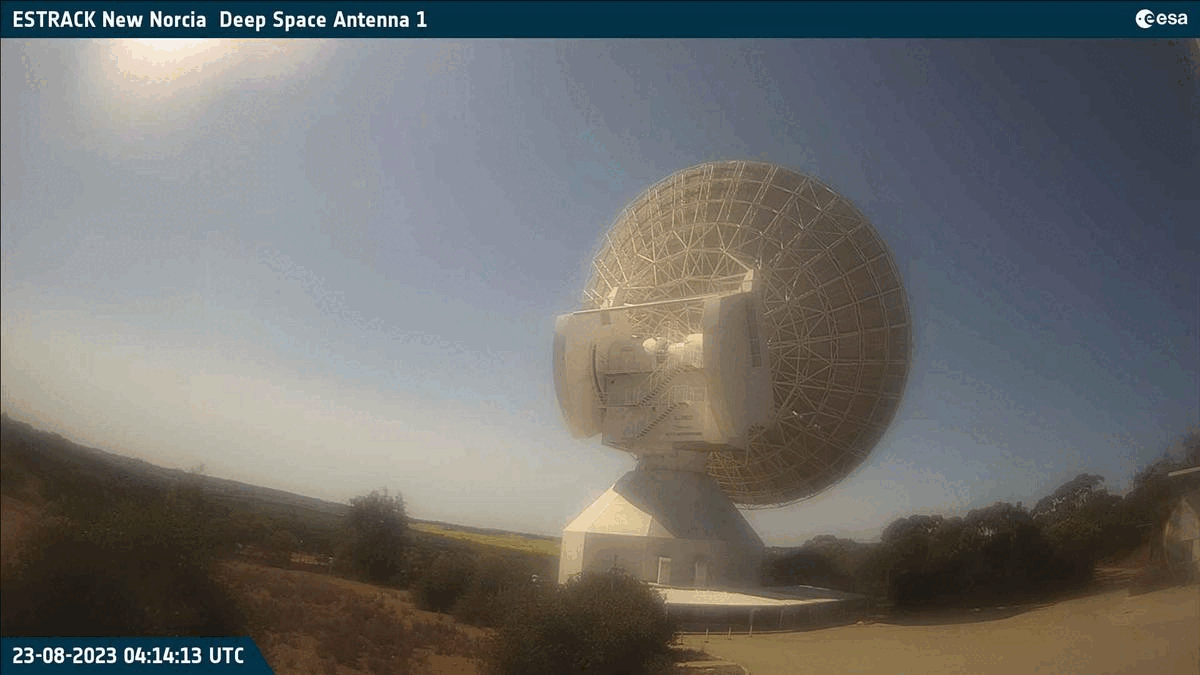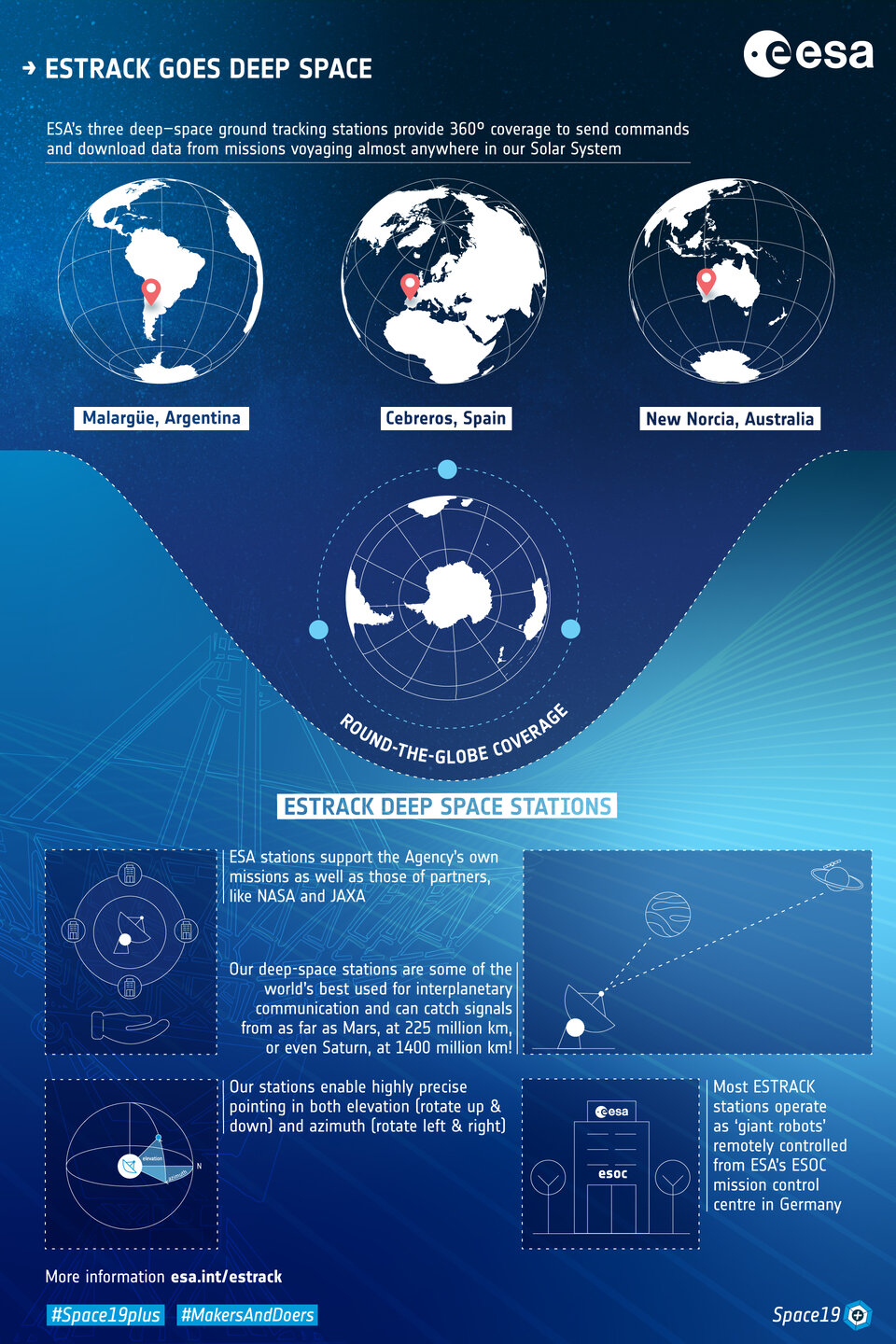24.08.2023
India’s Chandrayaan-3 successfully lands on the Moon

The Indian Space Research Organisation (ISRO) has successfully landed its Chandrayaan-3 Lander Module on the surface of the Moon.
What happened?

Chandrayaan-3 launched from the Satish Dhawan Space Centre in Sriharikota Range (SDSC SHAR), India, on 14 July 2023 on a mission to demonstrate new technologies and to achieve India’s first soft landing on another celestial body.
The spacecraft arrived in lunar orbit on 5 August. On 17 August, the lander module separated from the propulsion module and soon after began its descent to the surface.
On 23 August, after a nail-biting wait, ISRO confirmed that Chandrayaan-3’s lander had successfully touched down in the Moon’s southern polar region as planned.
“Congratulations ISRO on this historic landing. ESA is proud to support the Chandrayaan-3 mission. Our ground stations are a core element of ESA’s support to its international partners, and I am pleased that with this activity, we are further strengthening ESA’s relationship with ISRO and with India. I look forward to supporting further pioneering ISRO missions, such as Aditya-L1, in the future,” says Rolf Densing, Director of Operations at ESA’s ESOC mission operations centre in Darmstadt, Germany.
How was ESA involved?

ESA is providing deep space communication support to the Chandrayaan-3 mission.
Communication is an essential part of every space mission. Ground stations on Earth keep operators connected to spacecraft as they venture into the unknown. Without ground station support, it’s impossible to get any data from a spacecraft, to know how it’s doing, to know if it is safe or even to know where it is.
For the Chandrayaan-3 mission, ESA is coordinating routine support from its Kourou station in French Guiana and from Goonhilly Earth Station Ltd in the UK. These stations compliment support from NASA’s Deep Space Network and ISRO’s own stations.

ESA’s 35-metre antenna in New Norcia, Australia, provided additional tracking support during the lunar landing, serving as a back-up for ISRO’s own ground station.
New Norcia received the stream of vital signs from the Chandrayaan-3 lander – information about its health, location and trajectory – in parallel with the ISRO station. This type of back-up support is common during key moments of a space mission such as a landing.
It was this stream of telemetry that was ultimately used to confirm the success of the landing.
ESA’s deep space support to international partners

Many national space agencies operate deep space tracking stations that enable them to locate, track, command and receive telemetry and scientific data from their distant spacecraft.
But sometimes, particularly for deep space missions, operators need to track or command a spacecraft when it is outside the field of view of their own antennas, or to have a second ‘pair of eyes’ on their spacecraft during crucial moments.
Thanks to its global ‘Estrack’ network of ground stations, ESA can help its partners track, command and receive data from spacecraft almost anywhere in the Solar System via its ESOC mission operations centre in Darmstadt, Germany.
The Estrack network consists of ESA’s own ground stations, located across the globe, and ESA-coordinated support from third-party stations such as Goonhilly Earth Station Ltd.
What happens next?
The lander will soon deploy its rover. During its mission on the surface, which will last for one lunar day (14 days on Earth), the rover will carry out a number of scientific experiments.
ESA stations will continue to relay telemetry and scientific data gathered by the mission’s rover and lander module until the end of the surface operations.
Quelle: ESA
+++
Chandrayaan 3 leaves an imprint of the Indian national emblem and ISRO logo on the Moon

Symbolizing India's presence on the Moon, the rear wheels of ISRO will leave behind the imprints of the national emblem of India, which depicts the Lion Capital of Ashoka at Sarnath, and the official logo of ISRO. This move has been conceived by the Chandrayaan 3 team to signify the presence of the rover on the lunar surface.
After Chandrayaan 3's successful landing on the Moon's surface on August 23, its rover Pragyan emerged from the lander's belly and manoeuvred onto the lunar terrain. The rear wheels of the rover carry the imprints of the emblem, depicting a lion, and the official ISRO logo. This step has been taken to symbolize India's enduring presence on the Moon.
A curtain-raiser video showcases the mission's launch, with the rover's rear wheels bearing the imprints.
The Moon's southern pole had perpetually remained in shadows, quite literally. Yet, the rover's mission will encompass collecting potential samples as evidence of water presence and illuminating the Moon's unlit region.
Chandrayaan 3 will focus on four distinct objectives while stationed on the lunar surface: firstly, studying moonquakes; secondly, investigating the thermal conductivity of the Moon's surface; thirdly, probing for signs of a plasma environment in proximity to the lunar terrain; and finally, precisely measuring the distance between Earth and the Moon.
India took a walk on the moon, says ISRO as Pragyan rover rolls out
The first picture of the six-wheeled robotic vehicle Pragyan rolling out of Vikram has been shared by Pawan K Goenka

Rover coming out of the Vikram lander on the ramp (Twitter/Pawan K Goenka)
New Delhi: The moon rover of India’s Chandrayaan-3 on Thursday morning rolled out from the spacecraft to begin its exploration of the uncharted lunar surface, Isro said on social media platform X, formerly known as Twitter.
The country’s space agency said that the spacecraft made a historic landing on the south pole of the moon last evening, making India the first country to achieve this feat.
"The Ch-3 Rover ramped down from the Lander and India took a walk on the moon. More updates soon," ISRO posted on X.
The first picture of the six-wheeled robotic vehicle Pragyan rolling out of Vikram has been shared by Pawan K Goenka, the chairman of Indian National Space Promotion and Authorisation Centre, a single-window, independent, nodal agency that functions as an autonomous agency in the Department of Space (DOS).
The Lander and the Rover with a mission life of one Lunar day (14 Earth days) have scientific payloads to carry out experiments on the lunar surface.
The Rover payloads are the LIBS or ‘Laser Induced Breakdown Spectroscope’ and the APXS or ‘Alpha Particle X-Ray Spectrometer’
The LIBS will determine Qualitative and quantitative elemental analysis and to derive the chemical Composition and infer mineralogical composition to further our understanding of Lunar-surface.
The APXS will determine the elemental composition (Magnesium, Aluminium, Silicone, Potassium, Calcium Titanium and Iron) of the Lunar soil and rocks around the lunar landing site.
Earlier today President Droupadi Murmu posted a congratulatory message for the ISRO scientists involved with the Chandrayaan-3 project.
Taking to her official handle on X, after the rover rolled out of the lander, President Murmu posted, "I once again congratulate the ISRO team and all fellow citizens for successful deployment of Pragyan-rover from inside Vikram-lander. Its rolling out a few hours after the landing of Vikram marked the success of yet another stage of Chandrayan 3."
"I look forward with excitement, alongside my fellow citizens and scientists to the information and analyses that Pragyan will acquire and enrich our understanding of the moon," the post read.
The successful lunar landing by the Indian Space Research Organisation (ISRO) came a day after a Russian lander — Luna-25 — crashed on the lunar surface during descent.
Prime Minister Narendra Modi who is currently attending the 15th BRICS Summit in Johannesburg joined virtually to track the final moments leading up to the touchdown by the Vikram lander.
As soon as the lander touched the lunar south face, PM Modi was seen sporting a big smile and joyously waving the tricolour. The ISRO had been releasing a series of up-close images of the moon, assisting the lander module in determining its position (latitude and longitude) by matching them against an on-board moon reference map.
Quelle: Deccan Chronicle
----
Update: 25.08.2023
.





Quelle: ISRO, Xwitter
----
Update: 26.08.2023
.
Chandrayaan-3 Mission: What's new here? Pragyan rover roams around Shiv Shakti Point in pursuit of lunar secrets at the South Pole



Quelle: ISRO, Xwitter
----
Update: 29.08.2023
.
Chandrayaan-3 Records Temperature Variation On Moon, ISRO Shares Graph
Chandrayaan 3: The graph illustrates the temperature changes on the lunar surface as the depth increases.

New Delhi:
Chandrayaan-3's Pragyan rover, on August 23, touched down on the lunar surface, making India the sole nation to achieve a soft landing on the South Pole of the Moon.
Following the significant breakthrough, the Indian space agency is extracting valuable insights from this region. Recently, the Indian Space Research Organisation (ISRO) shared a graph on X — previously known as Twitter.
The graph illustrates the temperature changes on the lunar surface as the depth increases. Accompanying the image, ISRO detailed the initial observations gained from the ChaSTE payload located on the Vikram Lander.
ISRO's Post On X:
Alongside the graph, ISRO explained, “ChaSTE (Chandra's Surface Thermophysical Experiment) measures the temperature profile of the lunar topsoil around the pole, to understand the thermal behaviour of the moon's surface. It has a temperature probe equipped with a controlled penetration mechanism capable of reaching a depth of 10 cm beneath the surface. The probe is fitted with 10 individual temperature sensors.”
They further elaborated that the graph depicts the temperature fluctuations on the lunar surface and nearby regions at different depths, recorded while the probe penetrated. This is the first-ever profile of its kind for the lunar south pole. Detailed observations are currently in progress.
What experts say:
Commenting on the graphic representation, ISRO scientist BHM Darukesha told news agency PTI, "We all believed that the temperature could be somewhere around 20 degrees centigrade to 30 degrees centigrade on the surface but it is 70 degrees centigrade. This is surprisingly higher than what we had expected."
Going into the details, Mr Darukesha explained the interesting temperature findings. He talked about how on Earth, if we dig just a little bit below the surface – around two to three centimetres – the temperature changes only a tiny bit, maybe by two to three degrees Celsius. But on the Moon, things are very different. When you dig to the same depth, there's a huge difference in temperature, about 50 degrees Celsius, he said.
From the international perspective, India is viewed as a space giant nation due to its tremendous progress in recent times, Prof Santabrata Das, Department of Physics, IIT Guwahati, told IANS. "Indeed, India is an emerging space power as ISRO successfully marks its footprints globally because of its capability in achieving goals in a cost-effective and time-efficient manner," Mr Das added.
Space research in India has evolved — from being primarily focussed on the needs or development of the country to “more serious”, Amit Kumar, a faculty at the Department of Aerospace Engineering, IIT Madras, said. The country is “working at par with whatever is happening around the world,” he added, referring to missions by space agencies of China, the US and others. "We also see these kinds of activities happening in India,” added Kumar.
“Chandrayaan-3 is an excellent technical demonstration where we have achieved what a very limited number of countries around the world have been able to achieve,” astrophysicist Prof. Varun Bhalerao at IIT Bombay, told IANS.
And this makes it extremely clear that we are among the top who actually are able to take up very ambitious, very difficult missions in space, he added. "And we are also able to do it for a low cost. And that is always going to be an important factor as more and more private enterprises from around the world enter into the space industry," he said.
Quelle: NDTV
----
Update: 30.08.2023
.
Pragyan, Vikram, Vikas: How did India's Chandrayaan-3 moon mission get its names?

